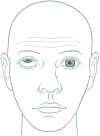Pediatric orbital fractures
- PMID: 24436730
- PMCID: PMC3699236
- DOI: 10.1055/s-0032-1332213
Pediatric orbital fractures
Abstract
It is wise to recall the dictum "children are not small adults" when managing pediatric orbital fractures. In a child, the craniofacial skeleton undergoes significant changes in size, shape, and proportion as it grows into maturity. Accordingly, the craniomaxillofacial surgeon must select an appropriate treatment strategy that considers both the nature of the injury and the child's stage of growth. The following review will discuss the management of pediatric orbital fractures, with an emphasis on clinically oriented anatomy and development.
Keywords: enophthalmos; entrapment; orbit; pediatric; trauma.
Figures









References
-
- Enlow D. Philadelphia, PA: WB Saunders; 1982. Handbook of Facial Growth.
-
- Dixon A, Hoyte D A, Rönning O. Salem, MA: CRC Press; 1997. Fundamentals of Craniofacial Growth.
-
- Messinger A Radkowski M A Greenwald M J Pensler J M Orbital roof fractures in the pediatric population Plast Reconstr Surg 198984213–216.; discussion 217–218 - PubMed
-
- Koltai P J, Amjad I, Meyer D, Feustel P J. Orbital fractures in children. Arch Otolaryngol Head Neck Surg. 1995;121:1375–1379. - PubMed
-
- Fortunato M, Manstein G. Facial bone fractures in children. Plast Reconstr Surg. 1982;70:650.
Publication types
LinkOut - more resources
Full Text Sources
Other Literature Sources
